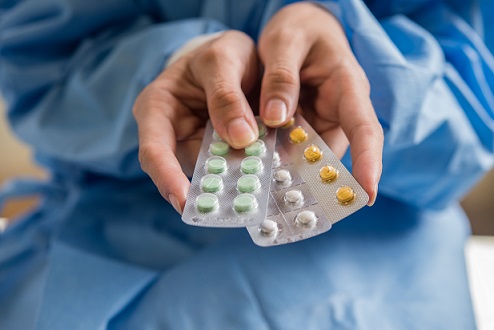Introduction:
In the intricate dance of hormones within our bodies, progesterone plays a vital role, often overshadowed by its more famous counterpart, estrogen. However, this unsung hero deserves recognition for its multifaceted functions and profound impacts on health and well-being. Let’s embark on a journey to explore the essence of progesterone, from its types to its myriad benefits.
Decoding the Different Types of Progesterone
Progesterone, though often a single term thrown around, comes in a few different forms. Let’s break down the three main types and explore their nuances:
- Endogenous : This is the “real deal,” the natural progesterone your body produces. In females, the champion producer is the corpus luteum, a temporary structure in the ovary that forms after ovulation. Endogenous fluctuates throughout the menstrual cycle, peaking after ovulation and dipping before menstruation.
-
Bioidentical : This is a synthetic form that mimics the exact molecular structure of endogenous progesterone. Bioidentical is often prescribed to address hormonal imbalances when the body’s natural production isn’t sufficient. It’s important to note that bioidentical one isn’t technically a bioidentical hormone, as it’s still manufactured in a lab. However, its structure is identical to what your body recognizes.
-
Progestins: These are the most commonly used type of “progesterone” in medications like birth control pills and hormone replacement therapy (HRT). Progestins are synthetic analogs of progesterone, meaning they have a similar chemical structure but not an identical one. This difference can lead to variations in how they interact with the body compared to natural one. Progestins are further categorized based on their chemical structure:
-
Pregnanes:
Derived directly from progesterone, these progestins (e.g., medroxyprogesterone acetate) tend to be less potent and may cause breakthrough bleeding.
-
Estranes:
Converted from testosterone, these progestins (e.g., norethindrone) can have some androgenic activity, potentially leading to side effects like acne or weight gain.
-
Gonanes:
Also derived from testosterone, these progestins (e.g., levonorgestrel) are generally more potent than pregnanes and may have fewer androgenic effects.
-
Choosing the Right Type:
The type of progesterone you might need depends on your individual situation. Here’s a simplified breakdown:
- Healthy menstrual cycle: If you’re looking to regulate your cycle or alleviate PMS symptoms, your doctor might recommend bioidentical type to mimic your body’s natural production.
- Birth control: Progestins are the mainstay in most birth control pills, as they effectively prevent ovulation and regulate periods.
- Hormone replacement therapy (HRT): Depending on your specific needs, HRT might utilize bioidentical type or progestins to address hormonal imbalances after menopause.

Balancing Act: The Many Actions of Progesterone
It’s actions vary depending on the target tissue and sex, but here’s a breakdown of its key functions:
In Females:
- The Uterus: It’s primary role is in the uterus, where it acts like a maestro in the menstrual cycle.
- Lining Prep: After ovulation, progesterone stimulates the endometrium (uterine lining) to thicken and develop a rich blood supply, creating a hospitable environment for a fertilized egg to implant.
- Pregnancy Support: If implantation occurs, progesterone levels surge to support the growing embryo. It suppresses uterine contractions, preventing premature labor, and stimulates the growth of milk ducts in the breasts.
- Menstrual Flow: If pregnancy doesn’t happen, Its level drop sharply. This signals the shedding of the thickened endometrium, resulting in menstruation.
- The Ovaries: It plays a feedback role in regulating ovulation. High levels after ovulation signal the pituitary gland to stop producing hormones that stimulate egg maturation, preventing further ovulation that cycle.
- Breasts: Progesterone, along with estrogen, prepares the breasts for milk production by stimulating the growth of milk ducts during pregnancy.
In Males:
- Sperm Production: While produced in much smaller quantities in males, it plays a supportive role in sperm production.
- Bone Health: It works synergistically with estrogen to maintain bone density and reduce the risk of osteoporosis.
Beyond the Bump: Benefits of Progesterone
Progesterone offers a surprising range of benefits beyond just its crucial role in reproduction. Here’s a closer look at how this hormone can positively impact your health:
Regulating the Menstrual Cycle:
Balanced levels are instrumental in maintaining a smooth menstrual cycle. It helps:
Reduce PMS:
It counters the effects of estrogen, which can dominate in the latter half of the cycle and contribute to PMS symptoms like bloating, cramps, and mood swings.
Prevent Irregular Periods:
It helps ensure the proper thickening and shedding of the uterine lining, leading to more predictable and regular periods.
Bone Health:
It works alongside estrogen to maintain strong bones. This can be particularly important for women approaching menopause when estrogen levels naturally decline, increasing the risk of osteoporosis. Progesterone helps mitigate this risk.
Improved Sleep:
It has a calming effect on the central nervous system, potentially promoting better sleep quality. This can be beneficial for those who experience sleep disturbances due to hormonal fluctuations.
Mood Regulation:
Significant progesterone fluctuations can contribute to mood swings, especially during the menstrual cycle. Maintaining optimal levels may help improve emotional well-being and reduce symptoms of anxiety and depression.
Positive Impact on Skin:
these hormone might play a role in regulating sebum production, potentially reducing acne breakouts.
Cognitive Function:
Some studies suggest progesterone may have neuroprotective properties and could benefit cognitive function, although more research is needed in this area.
Pregnancy and Beyond:
Of course, progesterone’s primary function is to support a healthy pregnancy. It creates a nurturing environment for the developing fetus and prepares the body for childbirth and breastfeeding. But its benefits can extend even after childbirth, potentially aiding in postpartum recovery and mood regulation.
Does Progesterone Cause Weight Gain?
Progesterone can lead to weight gain due to fluid retention, increased appetite, altered fat storage, and metabolic changes, commonly observed during the luteal phase of the menstrual cycle, pregnancy, hormone replacement therapy (HRT), and some birth control methods. It can prompt the body to retain water temporarily and boost appetite, potentially increasing calorie intake. Moreover, it affects fat distribution and metabolism, influencing weight. Managing progesterone-related weight gain involves a balanced diet, reduced sodium intake, regular exercise, hydration, stress reduction, and healthcare provider consultation for significant weight changes and potential medication adjustments.
Foods That Boost Progesterone :
- Foods rich in Vitamin B6:Vitamin B6 is involved in many bodily functions and plays a role in progesterone production. Good sources include chickpeas, bananas, potatoes, and salmon .
- Zinc-rich foods: Zinc is a mineral that’s crucial for ovulation and progesterone synthesis. Include pumpkin seeds, cashews, lentils, and black beans in your diet.
- Foods with Vitamin C:Studies suggest Vitamin C may be linked to increased levels. Broccoli, oranges, kiwi, and red bell peppers are all excellent sources.
- Omega-3 fatty acids: These healthy fats may help regulate hormones and cycles. Fatty fish like salmon, flaxseeds, and walnuts are good sources.
- Magnesium-rich foods: Magnesium is a mineral that supports overall hormonal health. Incorporate leafy greens, nuts, seeds, and whole grains into your diet.
The Final Note: Consulting a Healthcare Professional
While progesterone offers a multitude of benefits, it’s important to remember that it’s just one piece of the hormonal puzzle. If you’re experiencing hormonal imbalances, consulting a healthcare professional is crucial. They can assess your individual needs and determine if supplementation is right for you. By understanding its role in your health, you can take charge of your well-being and create hormonal harmony.
Frequently Asked Questions (FAQs) :
It is a hormone produced mainly by the ovaries after ovulation (the release of an egg). It plays a vital role in the menstrual cycle and pregnancy.
Prepares the uterus: It thickens the lining of the uterus (endometrium) to create a welcoming environment for a fertilized egg. Regulates menstruation: It helps regulate the menstrual cycle by promoting the shedding of the uterine lining if pregnancy doesn't occur, leading to your period. Supports pregnancy: During pregnancy, It helps maintain the uterine lining, prevents contractions, and supports the development of the fetus. Other functions: It may also influence mood, sleep, and bone health.
Symptoms can vary but may include: Irregular periods or missed periods PMS (premenstrual syndrome) symptoms like mood swings, bloating, and cramps Spotting between periods Difficulty getting pregnant Vaginal dryness Trouble sleeping
A doctor can diagnose low level through a simple blood test, typically called a progesterone test or PGSN.
Treatment for low level depends on the cause and your individual needs. Here's a breakdown of common approaches: Progesterone Supplementation: This is the most common treatment for low Progesterone. It comes in various forms, each with its advantages and disadvantages: Pills: Easiest to take but may have side effects like headaches or bloating. Creams or gels: Applied vaginally or topically, they can bypass the digestive system and potentially reduce side effects. Suppositories: Inserted into the vagina, they offer localized delivery and may be preferred for certain situations. Your doctor will determine the right dosage, form, and duration of treatment based on your specific needs.
It is generally safe when used under a doctor's supervision. However, it can have side effects like breast tenderness, headaches, and mood swings.
Women with irregular periods or experiencing difficulty getting pregnant Women undergoing fertility treatments like in vitro fertilization (IVF) Women with certain hormonal imbalances Women experiencing symptoms of perimenopause or menopause (when progesterone levels naturally decline) What is progesterone?
What does progesterone do?
What are the symptoms of low progesterone?
How is low progesterone diagnosed?
How is low progesterone treated?
Is progesterone safe?
Who might need progesterone treatment?



